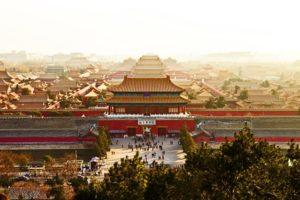Fodor's Expert Review Yunju Temple
To protect the Buddhist canon from destruction by Taoist emperors, the devout Tang-era monk Jing Wan carved Buddhist scriptures into stone slabs that he hid in sealed caves in the cliffs of a mountain. Jing Wan spent 30 years creating these tablets until his death in AD 637; his disciples continued his work for the next millennium into the 17th century, thereby compiling one of the most extensive Buddhist libraries in the world, a mind-boggling collection of 14,278 minutely carved Buddhist tablets. A small pagoda at the center of the temple complex commemorates the remarkable monk. Although the tablets were originally stored inside Shijing Mountain behind the temple, they're now housed in rooms built along the temple's southern perimeter.
Four central prayer halls, arranged along the hillside above the main gate, contain impressive Ming-era bronze Buddhas. The last in this row, the Dabei Hall, displays the spectacular Thousand-Armed Avalokiteshvara. This... READ MORE
To protect the Buddhist canon from destruction by Taoist emperors, the devout Tang-era monk Jing Wan carved Buddhist scriptures into stone slabs that he hid in sealed caves in the cliffs of a mountain. Jing Wan spent 30 years creating these tablets until his death in AD 637; his disciples continued his work for the next millennium into the 17th century, thereby compiling one of the most extensive Buddhist libraries in the world, a mind-boggling collection of 14,278 minutely carved Buddhist tablets. A small pagoda at the center of the temple complex commemorates the remarkable monk. Although the tablets were originally stored inside Shijing Mountain behind the temple, they're now housed in rooms built along the temple's southern perimeter.
Four central prayer halls, arranged along the hillside above the main gate, contain impressive Ming-era bronze Buddhas. The last in this row, the Dabei Hall, displays the spectacular Thousand-Armed Avalokiteshvara. This 13-foot-tall bronze sculpture—which actually has 24 arms and five heads and stands in a giant lotus flower—is believed to embody boundless compassion. A group of pagodas, led by the 98-foot-tall Northern Pagoda, is all that remains of the original Tang complex. These pagodas are remarkable for their Buddhist reliefs and ornamental patterns. Heavily damaged during the Japanese occupation and again by Maoist radicals in the 1960s, the temple complex remains under renovation.
Yunju Temple is 70 km (43 miles) southwest of central Beijing. By bus, take No. 917 from Tianqiao Long-distance Bus Station to Liangxiang Ximen, then change to Fangshan Bus Nos.12, 19, 31 to Yun Ju Si.
READ LESS







